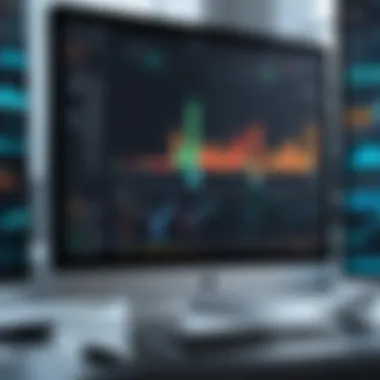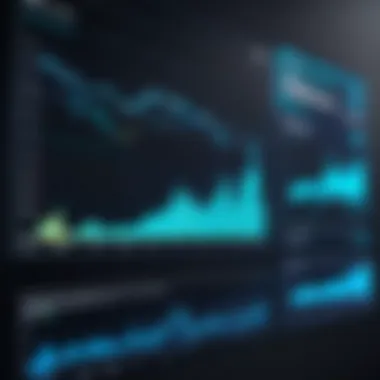Futures Software: A Comprehensive Analysis


Intro
In the realm of finance, innovation is a constant factor that shapes trading strategies and operational efficiencies. Among the myriad of tools available, futures software plays a critical role in the futures market. This article aims to provide a deep exploration of futures software, focusing on its intricacies, functionalities, and the vital considerations for selection. With the financial landscape evolving rapidly, understanding these elements becomes crucial for professionals aiming to enhance their trading capabilities.
Overview of Core Features
Futures software serves as an indispensable tool for traders, acting as the backbone of their trading activities. Understanding its core features is essential to grasp its functionality in the trading environment.
Description of Essential Functionalities
At its core, futures software provides functionality that supports trade analysis, risk management, and order execution. Key functionalities include:
- Market Monitoring: Traders use software to monitor price fluctuations and trends in the futures market.
- Automated Trading: Many platforms support algorithmic trading, allowing traders to execute orders automatically based on predefined strategies.
- Risk Assessment Tools: These include functionalities that assess market volatility, aiding traders in making informed decisions.
- Reporting and Analytics: Robust reporting features enable users to analyze past trades and strategize future ones, crucial for performance evaluation.
Comparison of Features Across Top Software Options
Different software platforms cater to various trading styles and market needs. Key players in the futures software sector include MetaTrader 5, MultiCharts, and NinjaTrader. When comparing these options, consider:
- User-Friendly Interface: Some platforms prioritize ease of use, while others cater to advanced traders with more complex features.
- Customizability: Look for software that allows traders to personalize their dashboards and functionalities.
- Integration Capabilities: High-quality software should integrate seamlessly with various trading tools and partners.
- Support and Community: Not all platforms offer robust support or community engagement, which can enhance user experience.
User Experience and Interface
In today’s trading environment, the user experience significantly influences the effectiveness of futures software. A well-designed interface can improve efficiency and reduce errors in trading activities.
Insights into UI/UX Design Aspects
Designing a user-friendly interface is paramount. Key aspects include:
- Navigation: Easy navigation paths enhance usability, allowing traders to focus on what matters—trading.
- Visual Clarity: Distinct graphs and data presentation can help users make more informed decisions quickly.
Importance of Usability and Accessibility
Usability drives user satisfaction and retention. Traders often favor platforms that are intuitive and accessible. This includes consideration for:
- Mobile Compatibility: Many traders require access on-the-go, so mobile-friendly solutions are vital.
- Learning Curve: Software with a lower learning curve can save time and prevent potential trading errors.
"A user-friendly interface is not just about aesthetics; it’s about facilitating informed decision-making in a time-sensitive environment."
Understanding Futures Software
Futures software plays a critical role in the complex world of financial trading. It supports traders, investors, and institutions in navigating the fast-paced and volatile futures market. In this section, we will delve into the definition and functionality of futures software, while also emphasizing its importance in modern trading practices.
Definition and Functionality
Futures software encompasses a variety of applications and tools designed for trading in futures markets. These platforms offer functionality that can aid users in managing their trades more efficiently. Basic features often include order entry, market analysis, and real-time data streaming. The software can also provide advanced charting options and technical analysis tools, which help traders identify trends and make informed decisions.
Specific functionalities may vary across different software platforms. Some solutions focus on trade execution speed and reliability, while others prioritize analytical capabilities to assist users in developing trading strategies. Additionally, many futures software options integrate with different data providers, allowing users to customize their trading experience based on personal needs and preferences.
Importance in Modern Trading
The significance of futures software in today's trading landscape cannot be understated. With markets moving rapidly, having the right tools can be the difference between profit and loss. Here are several aspects that underscore its relevance:
- Efficiency: Futures software streamlines the trading process. This can save traders valuable time by automating tasks such as trade entries and exits.
- Data-Driven Decisions: As the market grows more sophisticated, the ability to analyze data quickly and accurately becomes essential. Futures software empowers users with tools needed to make data-driven decisions.
- Risk Management: Effective risk management is crucial in futures trading. Software often includes features such as stop-loss orders and risk analytics, enabling traders to safeguard their investments.
- Adaptability: The futures market is influenced by various factors, including economic events and geopolitical shifts. Robust futures software can adapt to such changes, giving traders a competitive edge.


"In a world defined by rapid market shifts, futures software stands as an indispensable tool for modern traders, providing insights and efficiencies that were previously unattainable."
Adopting a reliable futures software solution can yield significant advantages for users. As traders strive to enhance their performance in the market, understanding what futures software can offer becomes a fundamental aspect of their strategic approach.
Types of Futures Software
Futures software plays a crucial role in today's trading environment. It provides the tools necessary for traders to navigate complex markets, interpret data, and execute trades efficiently. Understanding the types of futures software available is essential for decision-makers and IT professionals who are looking to optimize their trading strategies. Each type serves distinct purposes and comes with unique benefits that cater to varying needs in the trading process.
Trading Platforms
Trading platforms are the central hub for executing futures trades. They provide users with the ability to buy and sell contracts on various futures markets in real-time. Leading trading platforms like MetaTrader 4, NinjaTrader, and TradeStation are designed to handle vast amounts of data while offering user-friendly interfaces. These platforms often come with features such as advanced charting tools, technical indicators, and customizable alerts.
The importance of a reliable trading platform cannot be overstated. It directly affects a trader's ability to react swiftly to market changes. Traders need platforms that are robust and capable of executing trades with minimal latency. In addition, features like risk management tools and integrated news feeds can help traders make more informed decisions.
Analysis Tools
Analysis tools are vital for traders seeking to understand market trends and make data-driven decisions. These tools offer comprehensive analytics that helps traders assess potential market movements. Popular analysis tools include Bloomberg Terminal, Eikon, and TradingView. They provide real-time data, technical analysis, and in-depth reports on market conditions and forecasts.
Traders benefit by utilizing these tools to analyze price movements, volume trends, and other key metrics. This helps in predicting future price fluctuations and identifying optimal entry and exit points. In this increasingly data-driven environment, having access to accurate information is a game-changer that can significantly enhance trading performance.
Risk Management Solutions
Risk management is an essential aspect of futures trading. Risk management software helps traders assess and mitigate potential losses. Solutions such as RiskMetrics and Palisade provide tools for scenario analysis and risk assessment. They allow traders to model various market conditions and understand their potential impact on their portfolios.
Effective risk management not only protects capital but also improves trading confidence. Traders who use these solutions can set appropriate stop-loss orders, diversify their investments, and employ various hedging strategies. Ultimately, robust risk management solutions lead to more sustainable trading practices, especially in volatile markets.
"Understanding the types of futures software available can significantly enhance trading strategies and risk management approaches."
In summary, the types of futures software, from trading platforms to analysis tools and risk management solutions, are integral in today’s financial landscape. Selecting the right software can lead to improved trading performance and better risk assessment, making a significant difference to traders in fulfilling their goals.
Key Features to Consider
When assessing futures software, understanding the key features is critical. This section focuses on three essential elements: user interface and experience, integration capabilities, and data security and compliance. Together, they shape how traders interact with the software and how effectively it meets their needs.
User Interface and Experience
A well-designed user interface (UI) enhances the interaction between the user and the software. This aspect is vital for both novice and experienced traders. An intuitive UI leads to increased efficiency since users can navigate through the software easily. Key factors to evaluate include:
- Clarity of Layout: Information must be presented in a clear and organized manner.
- Responsive Design: The software should function seamlessly across various devices, including desktops and tablets.
- Customization Options: Traders often benefit from the ability to tailor screens with charts and relevant data to fit their trading style.
A positive user experience (UX) fosters user retention and satisfaction. If traders find the software easy to use, they are more likely to utilize its features effectively.
Integration Capabilities
Integration with existing tools is another vital feature to consider. Futures software that can connect with other platforms saves time and ensures cohesion in operations. Potential integrations may include:
- Brokerage Accounts: Linking the software with brokerage platforms enables immediate trade execution.
- Data Feeds: Access to real-time market data enhances analysis and decision-making.
- Risk Management Tools: Integrating specific risk assessment solutions allows traders to monitor their strategies more effectively.
The ability to efficiently integrate ensures a smooth workflow, enhancing overall productivity and reducing the chance of errors. This capability should be thoroughly evaluated before deciding on a software solution.
Data Security and Compliance
In today's digital trading environment, data security cannot be overstated. Protection of sensitive information and compliance with regulatory standards are paramount. Essential considerations include:


- Encryption Protocols: Look for software equipped with robust encryption methods to safeguard data.
- User Access Controls: Implementing tiered access can help maintain confidentiality and protect against unauthorized use.
- Regulatory Compliance: Traders must ensure the software adheres to industry regulations, which vary by jurisdiction.
This focus on data security and compliance not only protects users but also builds trust in the software being used.
"A software's reliability and security features define how traders perceive their capabilities and readiness in a volatile marketplace."
Evaluating Software Options
Evaluating software options is a crucial phase when selecting futures trading software. This process impacts not only the performance of trading strategies but also the overall trading experience. It involves a systematic approach to analyze various software available in the market, ensuring that the chosen platform aligns with traders’ specific needs and goals.
There are several elements to consider during the evaluation process. Key features include user experience, functionality, integration capabilities, and security measures. Each factor can significantly influence decision-making, and overlooking them can lead to unsatisfactory outcomes.
A thoughtful evaluation leads to several benefits:
- Enhanced Trading Efficiency: Choosing the right software can streamline trading processes, reducing time spent on routine tasks.
- Increased Profitability: A good platform can help traders better analyze market conditions, which may lead to more informed trading decisions and potential profit increases.
- Risk Management: Advanced tools which help to mitigate risks are essential, and evaluating options allows traders to select software with robust risk management features.
As the trading landscape evolves, understanding the criteria for evaluating software options becomes ever more vital. It helps traders remain adaptable and better navigate challenges presented by market fluctuations and regulatory changes.
Comparative Analysis of Leading Software
A comparative analysis of leading futures trading software is necessary to understand their strengths and weaknesses. Software like TradeStation, NinjaTrader, and Thinkorswim offer diverse features catering to different trading styles.
When comparing these platforms, consider:
- Functionality: What tools does the software offer for technical analysis? Are there automated trading options?
- Fees and Commissions: Analyze pricing structures. Some platforms may charge monthly fees or commissions on trades, which can affect overall profitability.
- Customization: Look into whether the software allows for personalized setups that can enhance trading efficiency.
It's also advisable to assess the updates released by these platforms. Many leading tools continuously evolve, integrating new technologies to improve user experience and performance.
User Reviews and Case Studies
User reviews and case studies provide real-world insights into the effectiveness of futures trading software. Feedback from current users can illuminate the practical implications of choosing a specific platform. Reviews often highlight strengths and weaknesses that may not be evident through features lists.
Finding reviews on forums like Reddit or community sites can give prospective users a sense of the software's usability and support quality. Additionally, case studies can demonstrate how various firms have implemented software solutions to improve trading strategies or operational efficiency.
In summary, evaluating software options is not merely about picking a tool; it involves a strategic selection process that sets the foundation for successful trading in the futures market. With careful consideration of features, real user experiences, and firm case studies, traders can make informed decisions that support their trading objectives.
Industry Trends Influencing Futures Software
In the rapidly evolving world of finance, futures software provides essential tools that adapt to various market dynamics. Understanding industry trends is pivotal for decision-makers and IT professionals as they seek to implement effective software solutions. These trends offer insights into emerging technologies and market behaviors, which can lead to informed decisions and strategic advantages. The benefits of recognizing these trends include enhanced functionality, improved risk management, and better alignment with regulatory expectations.
Technological Advancements
Technological advancements drive significant shifts in how futures software operates. Innovations such as cloud computing, big data analytics, and blockchain technology have revolutionized not only the way trades are executed but also how data is analyzed and utilized.
- Cloud Computing: This technology allows for scalable solutions that financial firms can adjust based on market demands. Its implementation reduces costs and enhances collaboration across teams.
- Big Data Analytics: The ability to process large volumes of data empowers traders to make quick and informed decisions. AI-driven analytics tools can identify patterns and trends that would be difficult for humans to discern, allowing for more accurate predictions in futures trading.
- Blockchain Technology: By enhancing transparency and security, blockchain builds trust in transactions. Financial firms that integrate blockchain into their futures software can minimize fraud and gain a competitive edge.
These advancements not only improve performance but also ensure that the software can adapt to the changing regulatory and market landscapes.
Regulatory Changes
Regulatory changes have a profound impact on futures software development and functionality. As governments globally impose stricter regulations in response to previous financial crises, software must evolve to remain compliant.
- Data Privacy: With laws such as GDPR in the European Union, futures software must ensure that user data is handled properly. Regulatory compliance has become a core requirement for software solutions.
- Transparency Requirements: Regulatory bodies often require detailed reporting of trades and risk assessments. Software solutions must provide accurate and real-time data to adhere to these requirements.
- Risk Management Regulations: Changes in the regulatory landscape may impose new capital requirements, which necessitate more robust risk management features in futures software. Firms need systems that can quickly adapt to new compliance guidelines without compromising operational integrity.


The integration of regulatory frameworks into futures software allows firms to mitigate risks effectively and engage in futures trading with confidence.
The Role of Artificial Intelligence
Artificial Intelligence is revolutionizing the landscape of futures trading software. Its integration brings several key benefits that fundamentally enhance trading strategies and overall performance. Understanding AI's role in this arena can equip professionals with the tools necessary to navigate the complexities of modern financial markets. Different aspects like efficiency, accuracy, and predictive capabilities distinguish AI in futures software. It also raises essential considerations regarding data security and algorithmic transparency.
AI in Market Analysis
AI technologies, such as machine learning and natural language processing, play an invaluable role in analyzing market data. Traders are inundated with vast amounts of information daily, from price movements to breaking financial news. AI algorithms can process and analyze this data more swiftly and accurately than traditional methods.
Some key advantages of AI in market analysis include:
- Rapid Data Processing: AI can analyze extensive datasets in real-time, identifying trends that may not be visible to human traders.
- Enhanced Predictive Analytics: AI algorithms can consider various factors, including historical data and market sentiment, to forecast future price movements.
- Risk Assessment: By analyzing patterns and anomalies, AI can help traders assess potential risks and identify optimal entry and exit points in trades.
These capabilities lead to more informed trading decisions, helping professionals optimize their strategies.
Automation of Trading Decisions
The automation of trading decisions through AI is increasingly common in futures trading software. AI systems can execute trades based on predefined strategies without the need for constant human oversight. This brings several advantages:
- Consistency: Algorithms operate under consistent rules, reducing the emotional bias that often affects human traders.
- Speed: Rapid execution of trades is critical in futures markets. AI systems can execute trades in milliseconds, capitalizing on fleeting opportunities.
- Scalability: Automated systems can manage multiple trades simultaneously, something that would be nearly impossible for an individual trader to replicate.
"The rise of AI in trading is not just about automation; it's about enabling better strategies and more informed decisions."
Despite these benefits, there are also considerable challenges to consider. For instance, reliance on AI can lead to a lack of oversight, raising issues around accountability. Furthermore, the algorithms' effectiveness depends heavily on the quality of data and continuous updates to the models in changing market environments. Therefore, while AI provides tools that significantly enhance trading activities, decision-makers must balance automation with human intuition and oversight.
User Support and Training
User support and training are critical components of futures software. Their significance cannot be overstated, as they directly impact the efficiency and proficiency with which users can leverage the software's capabilities. Effective support ensures that users can navigate the complexities of futures trading, while robust training programs equip them with the skills necessary to make informed decisions.
Availability of Resources
The availability of resources is a key factor in evaluating user support. Resources can take many forms, including documentation, tutorials, and community forums. Comprehensive documentation provides users with a solid understanding of software functionality. It offers step-by-step guides, FAQs, and troubleshooting tips that can help resolve common issues.
Tutorials, whether in video format or interactive modules, also play an essential role. They allow users to learn at their own pace, focusing on specific features or strategies relevant to their needs. Community forums facilitate interaction among users, promoting knowledge sharing and problem-solving. Engaging with other traders can foster a deeper understanding of the software and enhance learning through real-world experiences.
Onboarding Processes
A well-structured onboarding process is paramount for new users. It serves as the first impression of the software and sets the tone for future interactions. Effective onboarding should include a thorough introduction to the software’s features, interface, and unique tools. Ideally, it involves live training sessions where users can ask questions and receive prompt feedback.
Accessible onboarding resources often enhance user retention. Users who feel supported from the beginning are more likely to remain engaged with the software long-term. Furthermore, continuous education, with refresher courses and insights into new features, keeps users informed and adept in navigating changes in the software landscape.
Future Developments in Futures Software
In the realm of futures software, future developments hold great importance. The market is continuously evolving, and decisions based on outdated systems can lead to significant disadvantages. Emerging technologies and market shifts influence how software is designed, deployed, and utilized. As trading becomes more complex, professionals must understand these developments to remain competitive.
Emerging Technologies
Emerging technologies like blockchain, machine learning, and big data are reshaping the futures trading landscape. These innovations offer numerous benefits:
- Real-time Data Processing: Trading platforms can analyze vast amounts of data instantly, enhancing decision-making.
- Improved Transparency: Blockchain technology ensures all transactions are recorded securely, promoting trust in market operations.
- Advanced Predictive Analytics: Machine learning algorithms can forecast market trends with increased accuracy, allowing traders to strategize effectively.
These technologies not only enhance operational efficiency but also provide traders with a competitive edge. Institutions that adapt to these advancements often experience improved performance and better outcomes.
Market Shifts and Adaptations
Markets today are dynamic. Therefore, it is essential for futures software to adapt quickly to shifting conditions. This includes:
- Global Market Integration: More investors are entering global markets, necessitating software that supports multiple asset classes across various geographies.
- Regulatory Changes: Software must comply with evolving regulations. Understanding these shifts is critical to avoid compliance issues and legal pitfalls.
- User-Centric Design: There is a growing demand for intuitive interfaces. Software developers need to focus on user experience to retain users and enhance satisfaction.
"The ability to adapt to market whims is paramount for any trading software."

